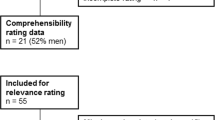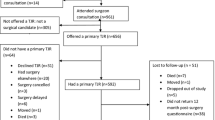Abstract
Purpose
To compare the psychometric properties of the Hughston Clinic Questionnaire (HCQ), EQ-5D and SF-6D in patients following arthroscopic partial meniscectomy surgery.
Methods
A total of 84 participants (86% men; mean age 40) were recruited. The questionnaires were completed on average 5 days, 6 weeks and 6 months after surgery and compared for internal consistency, convergent validity, sensitivity to change and floor and ceiling effects.
Results
Internally, the HCQ was the most consistent instrument (α = 0.923) followed by the SF-6D and EQ-5D. The EQ-5D and SF-6D were moderately correlated with the HCQ (ρ = 0.499 and 0.394, respectively). Six weeks after surgery, the most sensitive measures were the HCQ and EQ-5D (effect size: 2.04 and 0.99, respectively), at 6 months, with a smaller cohort (n = 42), again it was the HCQ and EQ-5D (effect size: 2.03 and 1.04, respectively). The SF-6D demonstrated no ceiling or floor effect during the study; the HCQ demonstrated a ceiling affect for 5% of respondents at 6 months after surgery compared to 26% of respondents for the EQ-5D.
Conclusion
For this patient population, our findings indicated that the EQ-5D was more consistently responsive to change over time, as a utility index was better at distinguishing differences between groups and reflected the results of the joint-specific HCQ for knee recovery better than the SF-6D. It is therefore recommended that for similar populations, the EQ-5D is preferable to the SF-6D for utilisation alongside the HCQ.
Similar content being viewed by others
Abbreviations
- EQ-5D:
-
Euroqol-5 dimension
- SF-6D:
-
Short form-6 dimensions
- SF-36:
-
36-item short form health survey
- HCQ:
-
Hughston Clinic Questionnaire
- HRQL:
-
Health related quality of life
- QALY:
-
Quality adjusted life year
- MID:
-
Minimally important difference
- SRM:
-
Standardised response mean
- SD:
-
Standard deviation
- CI:
-
Confidence interval
- ICC:
-
Intraclass correlation coefficient
References
Sonline, H. E. (2011). NHS hospital episode statistics: W82.2 endoscopic resection of semilunar cartilage NEC. http://www.hesonline.nhs.uk Accessed 25th January 2011.
Goodwin, P. C., Morrissey, M. C., Omar, R. Z., Brown, M., Southall, K., & McAuliffe, T. B. (2003). Effectiveness of supervised physical therapy in the early period after arthroscopic partial meniscectomy. Physical Therapy, 83(6), 520–535.
Brazier, J., Ratcliffe, J., Salomon, J., & Tsuchiya, A. (2007). Measuring and valuing health benefits for economic evaluation. Oxford: Oxford University Press.
Brooks, R. (1996). EuroQol: The current state of play. Health Policy, 37, 53–72.
Brazier, J., Roberts, J., & Deverill, M. (2002). The estimation of a preference based measure of health from the SF-36. Journal of Health Economics, 21(2), 271–292.
National Institute for Health, Clinical Excellence. (2004). Guide to the methods of technology appraisal. London: NICE.
Rasanen, P., Roine, E., Sintonen, H., Semberg-Konttinen, V., Ryynanen, O. P., & Roine, R. (2006). Use of quality-adjusted life years for the estimation of effectiveness of health care: A systematic literature review. International Journal of Technology Assessment in Health Care, 22(2), 235–241.
Jenkinson, C. D., Layte, R. D., & Lawrence, K. M. (1997). Development and testing of the medical outcomes study 36-item short form health survey summary scale scores in the United Kingdom: Results from a large-scale survey and a clinical trial. Medical Care, 35(4), 410–416.
Perdue, P. S., Jr., Hummer, I. C., Colosimo, A. J., Heidt, R. S., Jr., & Dormer, S. G. (1996). Meniscal repair: Outcomes and clinical follow-up. Arthroscopy, 12(6), 694–698.
O’Connor, D. P., Brinker, M. R., & Woods, G. W. (2002). Preoperative health status of patients with four knee conditions treated with arthroscopy. Clinical Orthopaedics & Related Research, 395, 164–173.
Johannesson, M., Jonsson, B., & Karlsson, G. (1996). Outcome measurement in economic evaluation. Health Economics, 5(4), 279–296.
Bharmal, M., & Thomas, I. J. (2006). Comparing the EQ-5D and the SF-6D descriptive systems to assess their ceiling effects in the US general population. Value in Health, 9(4), 262–271.
van Stel, H. F., & Buskens, E. (2006). Comparison of the SF-6D and the EQ-5D in patients with coronary heart disease. Health and Quality of Life Outcomes, 4, 20. doi:10.1186/1477-7525-4-20. http://www.hqlo.com/content/4/1/20.
Longworth, L., & Bryan, S. (2003). An empirical comparison of EQ-5D and SF-6D in liver transplant patients. Health Economics, 12(12), 1061–1067.
Marra, C. A. P. P., Esdaile, J. M. M. D. M. P. H., Guh, D. M., Kopec, J. A. M. D. P., Brazier, J. E. P., Koehler, B. E. M. D. F., et al. (2004). A comparison of four indirect methods of assessing utility values in rheumatoid arthritis. Medical Care, 42(11), 1125–1131.
Marra, C. A., Woolcott, J. C., Kopec, J. A., Shojania, K., Offer, R., Brazier, J. E., et al. (2005). A comparison of generic, indirect utility measures (the HUI2, HUI3, SF-6D, and the EQ-5D) and disease-specific instruments (the RAQoL and the HAQ) in rheumatoid arthritis. Social Science and Medicine, 60(7), 1571–1582.
Brazier, J., Roberts, J., Tsuchiya, A., & Busschbach, J. (2004). A comparison of the EQ-5D and SF-6D across seven patient groups. Health Economics, 13(9), 873–884.
Bryan, S., & Longworth, L. (2005). Measuring health-related utility: Why the disparity between EQ-5D and SF-6D? European Journal of Health Economics, 6(3), 253–260.
Flandry, F., Hunt, J. P., Terry, G. C., & Hughston, J. C. (1991). Analysis of subjective knee complaints using visual analog scales. American Journal of Sports Medicine, 19(2), 112–118.
Brazier, J. E., Harper, R., Munro, J., Walters, S. J., & Snaith, M. L. (1999). Generic and condition-specific outcome measures for people with osteoarthritis of the knee. Rheumatology, 38(9), 870–877.
Fransen, M., & Edmonds, J. (1999). Reliability and validity of the EuroQol in patients with osteoarthritis of the knee. Rheumatology, 38(9), 807–813.
Bennell, K., Bartram, S., Crossley, K., & Green, S. (2000). Outcome measures in patellofemoral pain syndrome: Test retest reliability and inter-relationships. Physical Therapy in Sport, 1, 32–34.
Hoher, J., Munster, A., Klein, J., Eypasch, E., & Tiling, T. (1995). Validation and application of a subjective knee questionnaire. Knee Surgery, Sports Traumatology, Arthroscopy, 3(1), 26–33.
Hooper, D. M., Morrissey, M. C., Drechsler, W. I., McDermott, M., & McAuliffe, T. B. (2001). Validation of the Hughston Clinic subjective knee questionnaire using gait analysis. Medicine and Science in Sports and Exercise, 33(9), 1456–1462.
Carlsson, A. M. (1983). Assessment of chronic pain. I. Aspects of the reliability and validity of the visual analogue scale. Pain, 16, 87–101.
Lysholm, J., & Gillquist, J. (1982). Evaluation of knee ligament surgery results with special emphasis on use of a scoring scale. American Journal of Sports Medicine, 10(3), 150–154.
Larson, R. L. (1974). Rating sheet for knee function. In I. Smillie (Ed.), Diseases of the knee joint. Edinburgh: Churchill Livingstone.
Noyes, F. R., & McGinniss, G. H. (1985). Controversy about treatment of the knee with anterior cruciate laxity. Clinical Orthopaedics & Related Research, 198, 61–76.
Kujala, U. M., Jaakkola, L. H., Koskinen, S. K., Taimela, S., Hurme, M., & Nelimarkka, O. (1993). Scoring of patellofemoral disorders. Arthroscopy, 9(2), 159–163.
Chesworth, B. M., Culham, E. G., Tata, G. E., & Peat, M. (1989). Validation of outcome measures in patients with patellofemoral syndrome. Journal of Orthopaedic and Sports Physical Therapy, 10(8), 302–308.
Harrison, E., Quinney, H., Magee, D., Sheppard, M. S., & McQuarrie, A. (1995). Analysis of outcome measures used in the study of patellofemoral pain syndrome. Physiotherapy Canada, 47(4), 264–272.
Eng, J. J., & Pierrynowski, M. R. (1993). Evaluation of soft foot orthotics in the treatment of patellofemoral pain syndrome. Physical Therapy, 73(2), 62–70.
Hurst, N. P., Kind, P., Ruta, D., Hunter, M., & Stubbings, A. (1997). Measuring health-related quality of life in rheumatoid arthritis: Validity, responsiveness and reliability of EuroQol (EQ-5D). British Journal of Rheumatology, 36(5), 551–559.
Hurley, M. V., Walsh, N. E., Mitchell, H. L., Pimm, T. J., Williamson, E., Jones, R. H., et al. (2007). Economic evaluation of a rehabilitation program integrating exercise, self-management, and active coping strategies for chronic knee pain. Arthritis & Rheumatoid Arthritis Care & Research, 57(7), 1220–1229.
Bryan, S., Bungay, H. P., Weatherburn, G., & Field, S. (2004). Magnetic resonance imaging for investigation of the knee joint and economic evaluation. International Journal of Technology Assessment in Health Care, 20, 222–229.
Dolan, P. (1997). Modeling valuations for EuroQol health states. Medical Care, 35(11), 1095–1108.
Ware, J., & Sherbourne, C. (1992). The medical outcomes study 36-item short-form health survey (SF-36). Medical Care, 30(6), 473–483.
Brazier, J., Usherwood, T., Harper, R., & Thomas, K. (1998). Deriving a preference-based single-index from the UK SF-36 health survey. Journal of Clinical Epidemiology, 51(11), 1115–1128.
Price, C., Arden, N., Coglan, L., & Rogers, P. (2005). Cost-effectiveness and safety of epidural steroids in the management of sciatica. Health Technology Assessment, 9(33), iii, 1–58.
Thomas, K. J., MacPherson, H., Ratcliffe, J., Thorpe, L., Brazier, J., Campbell, M., et al. (2005). Longer term clinical and economic benefits of offering acupuncture care to patients with chronic low back pain. Health Technology Assessment, 9(32), iii–iv, ix–x, 1–109.
van den Hout, W. B., de Jong, Z., Munneke, M., Hazes, J. M. W., Breedveld, F. C., & Vliet Vlieland, T. P. M. (2005). Cost-utility and cost-effectiveness analyses of a long-term, high-intensity exercise program compared with conventional physical therapy in patients with rheumatoid arthritis. Arthritis and Rheumatism, 53(1), 39–47.
van den Hout, W. B., Vermeulen, H. M., Rozing, P. M., & Vliet Vlieland, T. P. M. (2005). Impact of adhesive capsulitis and economic evaluation of high-grade and low-grade mobilisation techniques. Australian Journal of Physiotherapy, 51(3), 141–149.
Emery, P., Kosinski, M., Li, T., Martin, M., Williams, G. R., Becker, J.-C., et al. (2006). Treatment of rheumatoid arthritis patients with abatacept and methotrexate significantly improved health-related quality of life. Journal of Rheumatology, 33(4), 681–689.
Michaels, J. A., Brazier, J. E., Campbell, W. B., MacIntyre, J. B., Palfreyman, S. J., & Ratcliffe, J. (2006). Randomized clinical trial comparing surgery with conservative treatment for uncomplicated varicose veins. British Journal of Surgery, 93(2), 175–181.
Freeman, B. J. C., Steele, N. A., Sach, T. H., Hegarty, J., & Soegaard, R. (2007). ISSLS prize winner: Cost-effectiveness of two forms of circumferential lumbar fusion: A prospective randomized controlled trial. Spine, 32(25), 2891–2897.
Khanna, D., Yan, X., Tashkin, D. P., Furst, D. E., Elashoff, R., Roth, M. D., et al. (2007). Impact of oral cyclophosphamide on health-related quality of life in patients with active scleroderma lung disease: Results from the scleroderma lung study. Arthritis and Rheumatism, 56(5), 1676–1684.
Slatkowsky-Christensen, B., Mowinckel, P., Loge, J. H., & Kvien, T. K. (2007). Health-related quality of life in women with symptomatic hand osteoarthritis: a comparison with rheumatoid arthritis patients, healthy controls, and normative data. Arthritis and Rheumatism, 57(8), 1404–1409.
Walters, S. J., & Brazier, J. E. (2005). Comparison of the minimally important difference for two health state utility measures: EQ-5D and SF-6D. Quality of Life Research, 14(6), 1523–1532.
Cronbach, L. J. (1951). Coefficient alpha and the internal structure of tests. Psychometrika, 16, 297–334.
Streiner, D. L., & Norman, G. R. (2003). Health measurement scales: A practical guide to their development and use (3rd ed.). Oxford: Oxford University Press.
Nunnally, J. C., Jr. (1978). Psychometric theory (2nd ed.). New York: McGraw-Hill.
Cohen, J. (1988). Statistical power analysis for the behavioural sciences (2nd ed.). Mahwah, NJ: Lawrence Erlbaum.
Bland, M. J., & Altman, D. G. (1997). Statistics notes: Cronbach’s alpha. British Medical Journal, 314, 572.
McDonough, C. M., & Tosteson, A. N. A. (2007). Measuring preferences for cost-utility analysis: How choice of method may influence decision-making. Pharmacoeconomics, 25(2), 93–106.
Acknowledgments
The authors thank the London Regional Office, North Thames Health Authority for their financial support of this study. Thanks also to the following clinicians and researchers who supported this study: M. Klarneta, I. Man, D. Morrissey, P. Knight, M. Brown, G. Southall, J. Dredge, S. Fellows, M. Barry, T. Bucknill, P. Earnshaw, M. El-Zebdeh, D. Goodier, J. Ireland, K. Kong, M. Lamba, T. McAuliffe, B.E. Okafor, V. Siva, and D Sweetnam.
Author information
Authors and Affiliations
Corresponding author
Rights and permissions
About this article
Cite this article
Goodwin, P.C., Ratcliffe, J., Morris, J. et al. Using the knee-specific Hughston Clinic Questionnaire, EQ-5D and SF-6D following arthroscopic partial meniscectomy surgery: a comparison of psychometric properties. Qual Life Res 20, 1437–1446 (2011). https://doi.org/10.1007/s11136-011-9880-0
Accepted:
Published:
Issue Date:
DOI: https://doi.org/10.1007/s11136-011-9880-0




